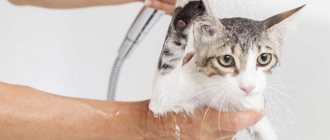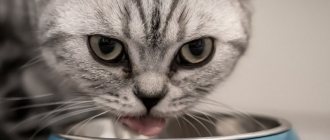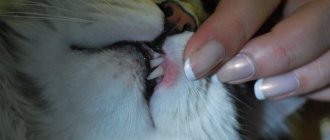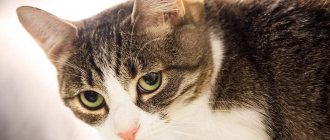A lack of glucose, or rather dextrose, in the body is typical not only for people, but also for their pets. Long-term deficiency of this element is fraught with death due to diabetic coma. To provide timely assistance, owners should know how diabetes manifests itself in cats and how to treat it at home with insulin injections.
The essence of the disease and the difference from diabetes insipidus
Pathology occurs when the level of glucose, formed due to the breakdown of sucrose, deviates from the norm. The breakdown product of sugar is directly related to the protein hormone insulin, which utilizes its excess and regulates carbohydrate metabolism.
Insufficient production or complete disappearance of insulin results in a sharp increase in blood glucose, accompanied by its artificial shortage. Cells do not recognize the excess in the body and gradually deplete their reserves.
The main burden falls on the kidneys. They work to the limit of their capabilities, trying to remove excess glucose along with urine. The patient experiences severe dehydration and excessive urination, since sugar absorbs moisture well.
Due to the lack of carbohydrates, energy is replenished from proteins and fats. As a result, the animal loses muscle mass, and ketone bodies are formed in its body, changing the pH of urine to the acidic side. This leads to the development of diabetic ketoacidosis - a dangerous pathology that causes fatal intoxication of the body in just a day or a couple of hours.
The symptoms of diabetes mellitus and diabetes insipidus in cats are very similar. But, if the first disease is associated with disturbances in the functioning of the pancreas, then the second is associated with dysfunction of the hypothalamus or pituitary gland.
Ready-made food for cats with diabetes
It is very convenient to feed mustachioed pets with ready-made industrially produced diabetic food - dry and wet. It is best to give elderly cats wet food and canned food - they are better digested and absorbed by an already middle-aged body. The dosage and frequency of feeding is indicated on each package or can. All ready-made foods for diabetic cats contain a large amount of protein and practically no carbohydrates.
- Young Again Zero Mature Health Cat Food ($32/1.8 kg dry);
- Young Again 50/22 Cat Food ($44/3.6 kg dry);
- Purina Veterinary Diet DM Dietetic Management (about RUB 1,200/1.5 kg dry);
- Purina Pro Plan (about 1,200 rub./1.5 kg dry, 130 rub./195 g dry food, up to 100 rub./85 g wet food);
- Vet Life Cat Diabetic (about RUB 1,900/1.2 kg);
- Prescription Diet Feline m/d (about 1500 rub./1.5 kg, 140 rub./156 g cons.);
- Royal Canin Diabetic DS46 (RUB 1,300/1.5 kg);
- Royal Canin Diabetic (RUB 75/100 g wet food).
Common Causes of Diabetes in Cats
The appearance of pathology is influenced by internal and external factors. In the first case, the anomaly turns out to be congenital. It is inherited from affected parents and is often diagnosed in the following breeds:
- Burma;
- Persians;
- British;
- Maine Coons;
- Norse.
Unlike internal ones, external causes can and should be dealt with through prevention. These include:
- poor nutrition, characterized by overfeeding or the use of low quality products;
- chronic stress and illness;
- bacterial and viral infections;
- lack of physical activity and excess weight;
- pathologies of the cardiovascular system;
- frequent false pregnancies, as well as some diuretics and hormonal drugs that cause changes in the pancreas;
- any types of pancreatitis.
Cats get sick 2 times less often than cats, since their bodies are less susceptible to hormonal changes. The risk group includes unsterilized pets over 7 years old who regularly experience empty heats.
Classification by type
Diabetes mellitus in cats is divided into 3 types. The classification is based on the cause of the disorder.
Insulin dependent
Characteristic of animals born from sick parents or suffering from an autoimmune disorder. In the insulin-dependent type, there is a gradual destruction of pancreatic cells responsible for the production of insulin. Over time, the organ completely degrades and cannot be restored. Despite the sad prognosis, this type of pathology practically does not occur.
Insulin-independent
Diagnosed in 70% of cases. Despite the stable production of the protein hormone, cells cease to recognize it or receive it in smaller volumes. Thanks to supportive therapy, the patient's condition can be stabilized. Deterioration is possible only with late treatment, when the insulin-independent type becomes insulin-dependent.
Secondary (acquired)
It develops as a result of complications of concomitant pathologies, intoxication and prolonged treatment with hormonal drugs. When the provoking factor is eliminated, the pet’s condition quickly stabilizes, since the pancreas is fully functional.
Treatment
Successful treatment of diabetes is based on good contact between the owner and the veterinarian, strict adherence to therapeutic regimens, and constant monitoring of the cat’s condition. The ultimate goal of therapy is to achieve remission of the disease. It is also important to remember that slightly elevated blood glucose levels during the day are normal for cats, as opposed to humans.
Insulin is the main drug used in the treatment of diabetes in cats. There are several dosage forms of insulin, varying in duration of action. The drug is administered subcutaneously (as a rule, owners quickly learn the skill of performing subcutaneous injections). This method of treatment is quite well tolerated by cats.
Diet. Several large studies have shown that combining a high-protein, low-carbohydrate diet has a significant effect on the rate of diabetes remission (compared to high-fiber diets). There are a large number of different brands of ready-made medicated food on the market, and your cat can choose the food that she likes best in terms of taste.
Also, dietary food allows you to control the patient’s weight (it is important to achieve a smooth, gradual weight loss in the cat over several months).
Glipizide (oral hypoglycemic drug). Available in tablets, it stimulates the production of insulin by pancreatic cells. Mainly intended for cats whose owners cannot inject their pets. Can be used in combination with insulin.
Symptoms: how to recognize the disease?
The onset of the disease is accompanied by a certain set of symptoms. It includes:
- increase in heart rate above 150 beats per minute;
- itching and peeling of the epidermis, fraught with the appearance of dermatitis;
- apathy and passivity (the sick animal constantly sleeps, avoiding unnecessary body movements);
- wounds that last too long due to poor blood clotting;
- partial baldness and deterioration in coat quality;
- acetone odor from the mouth, caused by the abundance of ketone bodies;
- diarrhea and vomiting;
- drying of mucous membranes and increased viscosity of saliva;
- increased thirst;
- clouding of the pupil and blurred vision.
All these disorders can easily be confused with other diseases, so if diabetes is suspected in cats, they check for 4 signs: rapid weight loss, increased appetite, increased thirst, copious and frequent urination. A sick pet constantly wants to eat, but still loses its weight, frightening its owners with protruding ribs and a sunken belly.
In advanced cases, convulsions, gait disturbance and fainting are noted. If these symptoms occur, you should contact your veterinarian as soon as possible and arrange an in-home appointment. If there are disorders of the central nervous system, the animal may not survive transportation and die on the way to the veterinary clinic.
Caring for a sick animal
When diagnosing diabetes mellitus, you should strictly follow the doctor’s recommendations and the diet prescribed by him. If an ill cat is obese or underweight, it is important to help her achieve a normal body weight, which is essential in the fight against the disease. Often, for diabetes mellitus, insulin injections of different effects are prescribed depending on the complexity and type of the disease. To achieve the best result, it is necessary to combine them with feeding the animal.
Food for a diabetic cat should meet the basic needs of its body. Glucose from food into the blood must flow as slowly as possible, otherwise the sick body will not withstand the load. For this reason, foods with a high protein content and low calorie content are recommended.
Diagnosis and tests
Diagnosis of diabetes mellitus in cats is necessary to exclude diabetes insipidus and other similar diseases: nervous disorders, helminthiasis, cystitis, poisoning and infections.
The list of mandatory tests includes urine and blood tests. Based on the results of the first study, a high level of ketone bodies is detected, and based on the results of the second, a glycemic curve is built. To display it, you need to donate blood several times in a row, maintaining an interval of 3 hours.
Ultrasound, ECG and X-ray are additional tests. With their help, the condition of the pancreas is determined, heart rate is measured and changes in other internal organs are recorded. With the disease, there is an enlargement of the liver, visible even with normal palpation.
After determining the type and cause of the pathology, the veterinarian draws up a treatment plan. In addition to drug therapy, for your pet to recover, you will need to review the current diet and adjust the living conditions.
Diagnosis of disease in cats
To make an accurate diagnosis, the veterinarian carefully examines the pet and asks the owner questions (what conditions are suspicious, whether hormonal drugs are used, if so, which ones, etc.). During the examination, the specialist pays attention to external signs of the disease: dull and crumpled hair, unsteady gait, dehydration, etc. Then the doctor excludes other conditions that cause signs of diabetes. This could be kidney failure, thyroid disease, etc.
Attention! The main sign that veterinarians look for is a persistently high level of sugar in the urine.
Other methods that are used for diagnosis:
- blood and urine test,
- x-ray,
- ultrasonography,
- analysis of thyroid hormones,
- electrocardiography (ECG),
- acid-base balance analysis, etc.
Only after an accurate diagnosis has been made, the veterinarian gives a prognosis and draws up a treatment program.
Treatment and supportive care
The secondary type of pathology is curable after eliminating the provoking factor. In other cases, the animal is prescribed lifelong maintenance therapy. It is based on a gradual decrease in sugar levels to normal and suppression of accompanying symptoms.
Insulin administration and blood sugar control
When donating blood on an empty stomach, the amount of glucose contained in it should not go beyond 3.4-6.1 mmol/l. If the result is less than the lower limit, hypoglycemia is prescribed in the diagnosis, and if it is more than the upper limit, diabetes is prescribed.
The level of this indicator will have to be regularly monitored at home. For convenience, it is recommended to purchase a glucometer. It is better to take blood for analysis from the tip of the ear, since the capillaries in the cat's fingers are located too deep. If this kind of research is new to you, follow these steps:
- Trim or completely remove the hair on the tip of your pet's ear.
- Prepare your glucometer and lightly massage your ear. This will help drive more blood to it.
- Carefully examine the inside of the ear and find the place where the maximum number of vessels intersect. This cluster is usually located 5 cm below the tip of the auricle.
- Prick the found area with a thin and well-sharpened needle. Through puncture should be avoided. It is enough to just inject it a little under the skin.
- If blood appears, quickly apply the test strip to it and let it absorb.
- Return the test strip to the meter and wait for the result to appear.
Unlike human skin, cat skin does not need to be treated with an antiseptic. The cat’s epidermis already has a special protective layer that prevents the penetration of pathogenic microorganisms.
To normalize high glucose levels, insulin injections into the withers or tablets are used. In emergency situations, a short-acting drug (Actrapid, Monodar) is administered into the animal’s body, and for lifelong treatment, a long-acting drug (Glargine, Detemir) is administered. Insulin is injected 2 times a day. It is safer to choose one that is produced using pig hormones. Preparations made from bovine and human active substances often cause a negative reaction from the immune system.
For the safety of your pet, you must strictly follow the dosages prescribed by your veterinarian. Exceeding them is fraught with the death of the animal. You should not give an injection if you accidentally miss a scheduled injection or incompletely administer the solution due to a furry diabetic vomiting.
First aid in case of emergency
If lethargy, convulsions and loss of consciousness occur, first aid must be provided as soon as possible. To relieve an attack, intravenous administration of a glucose solution is used, but if this drug is not at hand, ordinary sugar or honey will do. Dissolve them in water and carefully pour them into the victim’s mouth. After this, call a doctor immediately.
Please note that infusing liquids while unconscious is strictly prohibited. The treatment solution may accidentally enter the lungs and cause aspiration pneumonia. If your pet has lost consciousness, all you have to do is give him an injection or wait for the veterinarian to arrive.
Drug therapy
When drawing up a treatment regimen for diabetes in cats, its causes and symptoms are taken into account. Depending on the diagnosis, a mustachioed patient may be prescribed:
- sedatives that reduce anxiety during frequent stress;
- antiviral and antibiotics that fight viral and bacterial infections;
- vasopressors and cardiotonics that regulate heart function;
- digestive enzymes, antiemetics, antispasmodics and analgesics necessary to eliminate the effects of pancreatitis.
To protect against false pregnancies, mandatory sterilization is carried out. The list of drugs for the treatment of chronic diseases that have caused pathological changes in the pancreas is adjusted to more suitable ones.
Special diet
If errors in nutrition are identified, it is necessary to completely review the diet. It is recommended to weigh daily portions to prevent overfeeding or lack of nutrients.
All diabetics are required to go on a special therapeutic diet and adhere to its rules throughout their lives. To do this, you need to reduce the amount of carbohydrates and fats in favor of proteins and fiber, and also reduce the size of a single serving, increasing the number of meals to 5 times a day.
If your pet is accustomed to natural food, then the new diet should contain the following products:
- lean meat (beef, turkey, chicken) and offal;
- lean sea fish;
- dietary soups;
- light broths with fresh herbs;
- quail or chicken eggs;
- fermented milk products with fat content within 1%;
- cinnamon and fenugreek seeds, which lower glucose levels.
Don't go to extremes. The diet should be rich in proteins, but not consist only of them. Otherwise, there is a high risk of kidney disease. Stick to the following indicators:
- fish, meat, eggs and offal – 50%;
- fermented milk products – 25%;
- vegetables and herbs – 25%.
You should avoid anything that is rich in preservatives, sweeteners, fats and carbohydrates. If a cat likes to eat cereals, then instead of oatmeal, corn and rice porridge, it is better for him to cook buckwheat. But veterinarians recommend eliminating grains altogether, since they do not provide any significant benefit to the cat’s body.
To save time, it is recommended to purchase high-protein dry food (Purina, Royal Canin, Hills) for animals with diseases of the endocrine system, containing no more than 4% carbohydrates. With it, you don’t have to bother with calculating the KBZHU, since all the standards are already written in the instructions on the package.
Caring for a furry diabetic
In addition to following a diet, daily injections and regular monitoring of sugar levels, you need to increase your pet's physical activity. Outdoor games will help you get rid of excess weight and prevent new exacerbations. In addition to mice, teaser rods and balls, you can purchase interactive toys. The pet can play with them without the participation of the owner.
The dosage of the drugs will have to be adjusted periodically. This furry diabetic needs to be shown to the doctor regularly along with the results of blood tests.
Diagnostics and therapy
We warn you once again - if any of the above symptoms appear, you should immediately notify your veterinarian. In the case when the cat has already fainted, or is in a pre-fainting state (disorientation in space, inappropriate behavior), you cannot hesitate for a minute - immediately take him to the clinic, since you need to stop the pathological condition as quickly as possible.
As we have already noted, hypoglycemia is diagnosed based on blood test results, and the specialist also takes into account accompanying clinical signs. In addition, it is very important to conduct a urine test, since it can help identify other pathologies (alkalosis, ketosis) that can lead to low blood sugar levels
It is very important to tell the veterinarian exactly why your cat felt unwell, what contributed to this, etc. . What treatment is prescribed? First, you urgently need to stabilize your blood glucose levels
Secondly, the root cause of the pathological condition should be found. If there is such a possibility, it must be eliminated immediately.
What treatment is prescribed? First, you urgently need your blood glucose levels Secondly, the root cause of the pathological condition should be found. If there is such a possibility, it must be eliminated immediately.
The approach depends on the severity of the symptoms. Mild symptoms can be successfully relieved by immediate oral administration of glucose solution or regular sugar . However, to reliably prevent the development of hypoglycemic coma, glucose must be urgently administered intravenously. This should be done only after a rapid blood test, since otherwise the animal can be “treated” until a hyperglycemic coma develops.
As for other treatments, they depend on the underlying cause. So, if a pancreatic tumor is detected, surgery is prescribed, but the problem can be solved through antibiotic therapy. Only an experienced veterinarian should prescribe treatment.
How to prevent relapses of hypoglycemia? There is only one reliable way - to regularly check blood glucose levels and feed the animal a diet that was prepared by a professional veterinary nutritionist . If you notice something wrong, notify your veterinarian immediately. When this is not possible, you can give the cat a small amount of sugar.
Important! If your pet constantly has hypoglycemia, you should not breed him, since a predisposition to diabetes is highly likely to be inherited.
Forecasts and statistics
A favorable prognosis is typical only for type 3. In other cases, the disease is incurable. Despite this, strict adherence to all medical recommendations makes it possible to stabilize the patient’s condition and prevent relapses. Thanks to proper care, a furry diabetic can live as long as healthy animals.
According to statistics, improvement in well-being is observed even in animals with an advanced form of the disease. But in such situations, veterinarians give a cautious prognosis, since some complications can become an insurmountable obstacle to recovery.
List of complications and dangerous conditions
The disease is rarely complicated by concomitant diseases at an early stage. Most often they appear only after a few years and include:
- cystitis;
- heart pathologies;
- cataract and retinopathy;
- liver and kidney failure;
- ketoacidosis;
- diabetic neuropathy and angiopathy;
- trophic ulcers;
- hypoglycemia;
- deformation and thinning of bones.
You should not wait for these complications to appear, since delayed treatment does not always produce results. If there are any signs of illness, take your pet to the veterinary clinic and wait for the veterinarian's conclusion.











